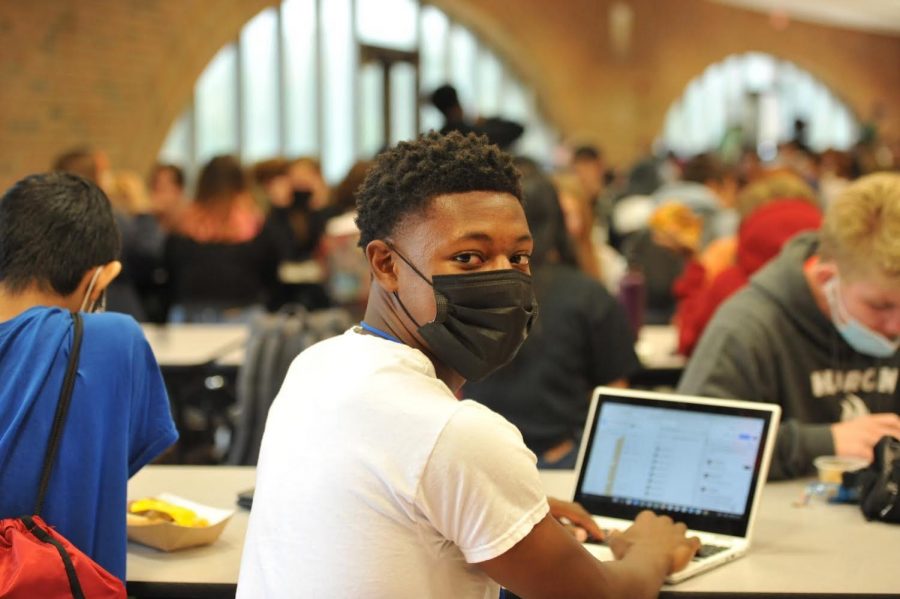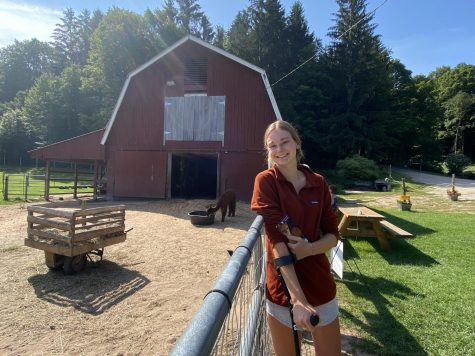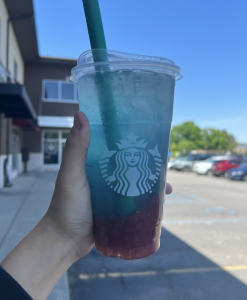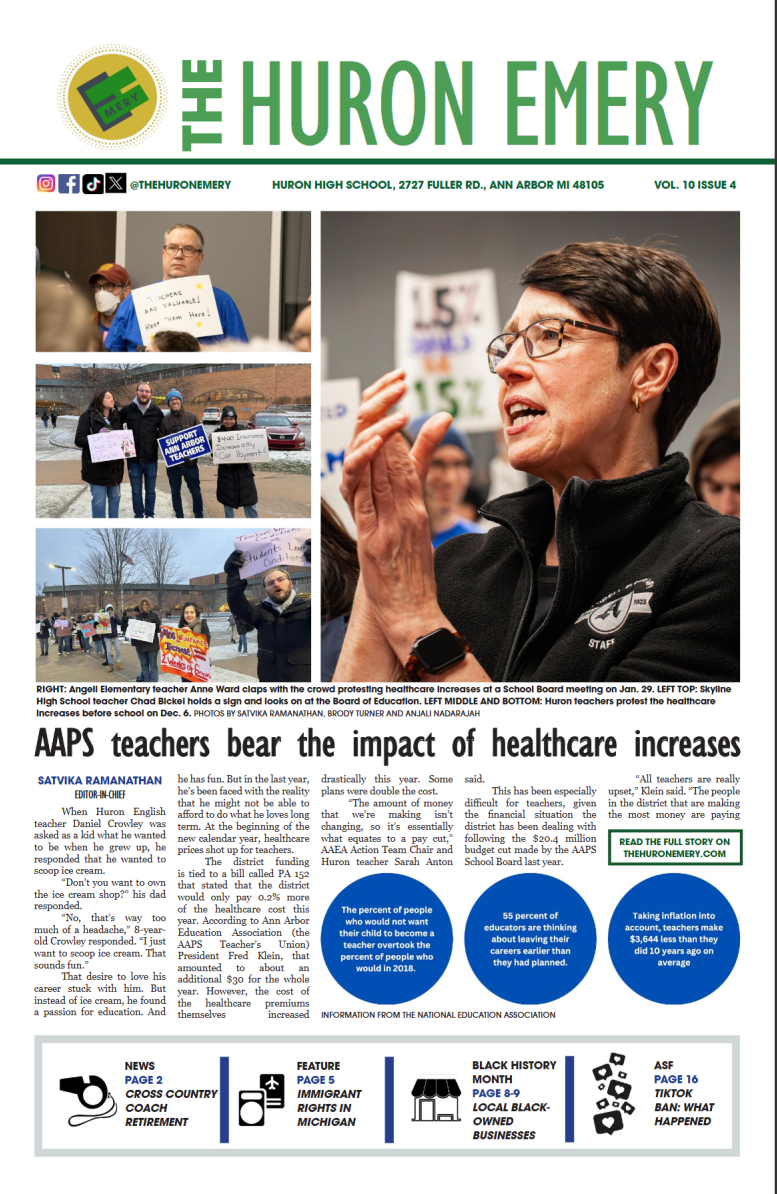After Effects: The costs of going back in-person
Ann Arbor Public Schools face new challenges of sub shortages, late buses, and quarantine
The cafeteria has become a holding loation for classes when there is a shortage of subsitute teachers.
November 4, 2021
Amidst returning fully in-person, Huron High School has been challenged with more than just the transition back to the classroom.
On Oct. 22, about 25 percent of AAPS’ 2,400 employees were absent.
Buses are late.
Students are being sent to the cafeteria.
Not to mention, the recent surge of COVID-19 cases at Huron are forcing teachers and students to spend about a week at home in quarantine.
This is all due to a shortage of staff throughout AAPS.
“Our sub-pool has been bigger than it’s ever been,” Superintendent Jeanice Swift said. “The COVID mitigations where we’re supposed to all stay home if we have any symptoms, it’s just making it where the number [of absences] are big.”
Staff absences change day-to-day, according to Swift.
“The concern about the distress of needing to close schools for inadequate staff is a significant concern,” Swift said in the Oct. 27 board of education meeting. “The concern is far greater that if as a result of a short staff situation, a student or a staff member would be placed at greater risk.”
Swift said in the meeting that since Monday, Oct. 25, there is a new batch of 687 substitutes that have been through the application process but cannot always teach.
Parent and current substitute for AAPS, Tamara Mayrend says that having school fulltime was paramount and AAPS is doing an amazing job balancing things.
“The staffing challenges around the area have been difficult for everyone,”Mayrend said. “There simply are not enough substitute teachers to make that happen right now. As a substitute when I work now, I don’t get breaks, I eat lunch with the kids in the classroom and overall am asked to do more. It’s to the point of rethinking picking up substitute assignments. The teachers are having the same experience. They are being asked to cover extra time all day, with no planning period or lunch break. If I am rethinking taking a day, they have got to be burning out.”
Mayrend also noticed an effect on her daughter’s learning when she had a substitute teacher for her math class at Huron.
“The sub would hand them papers and tell them to do the work,” Mayrend said. “My daughter became frustrated because several times the substitute would say ‘You learned this in school already.’”
The thing is my daughter likely learned that material during the start of the pandemic, which means she probably didn’t actually learn the concept.”
Substitute teachers are not necessarily certified to teach the subject matter in the classrooms they are assigned to. This means that students are in a tough spot needing to rely on themselves and external resources.
AAPS teachers use Schoology to communicate with students while they are in and out of school. Each teacher has a calendar, daily lessons and handouts in their course pages.
“My daughter was very frustrated and concerned that those worksheets would be in the gradebook,” Mayrend said. “In the end they were not. However, the weeks when the substitute was in class, there was not a lot of learning and a lot of frustration and anxiety.”
Mayrend also suggests that parents should become substitutes or consider volunteering.
“It certainly doesn’t work for everyone,” Mayrend said. “It is one Band-Aid that could be applied. There seems to be a challenge with the teaching profession that needs to be addressed at a higher level. As consumers, we need to be patient. As parents, we need to be patient. Until you walk into the classroom and realize what’s happening, it’s harder to understand. Solutions seem to be few and far between unless we get people to help with the classrooms as teachers or otherwise.”
AAPS observed that Mondays and Fridays had the most staff absences, so they increased sub payments, making AAPS hold the highest sub rates in Washtenaw County.
“We are making progress together through this fall,” Swift said. “The team is working incredibly hard to navigate this COVID time. We do believe that things are going to improve.”
Additionally the AAPS leadership team is also redeploying staff across the district and they have five full-time subs at the elementary level and six at the secondary level.
The other new challenge this year is buses running late. Swift said it should be getting better. More drivers are in training now to solve it.
“It’s similar with all the positions,” Swift said. “We are a little bit lower on drivers. It’s just that people have to be asked.”
Each morning, there are 100 bus routes, according to Swift. AAPS has 90 drivers and is short of 10 drivers. Five leadership team members are driving everyday and 15 drivers are in training. They will be brought to duty in the coming weeks.
“The cushion for substitute drivers still remains thin,” Swift said. “That’s where we continue to have our challenge, but we are consistently delivering our students far better than we were at the very beginning of the year.”
According to the AAPS COVID-19 dashboard, as of the week of Oct. 24, Huron is leading with 45 COVID cases, more than half of the cases of the monthly total of all the AAPS high schools.
Junior Natalie Muenz was recently quarantined at home after herself and other family members tested positive for COVID-19.
“I was really sick for about five days, “ Muenz said. “I could not taste or smell, and I was always exhausted.”
Muenz and her family each “took a floor” to distance themselves from each other as much as possible.
“Many teachers just gave me reading assignments,” Muenz said. “ And things to look over, but there were not a lot of things that I needed to turn in.”
While at home, Muenz did attend some Zoom calls for classes. Many teachers were understanding of the situation and did not give out that much work.
Even though she was extremely bored, Muenz did find some things to do with her time.
“I binge watched six seasons of Grey’s Anatomy,” Muenz said. “I also FaceTimed my friends frequently so I had people to talk to.“I rate my overall experience a 2/10; I did get to chill out and watch a lot of TV, but now I am swamped with work and struggling to catch up.”
According to Swift, we are not going back to remote learning due to vaccinations and AAPS watching the cases. Schools (individually) may go remote for a period of time, but not the whole district.
Parent Allison Jeter is an active helper in her childrens’ schools — King Elementary School, Clague Middle School and Skyline High School. As a substitute, she says she is elated to have a bit of normalcy but is sad when it came to hearing about the staff shortages.
“ I have a great deal of understanding about both the teacher/staff shortages and the bus driver shortage [and route adjustments],” Jeter said. “I think the people to blame — at least for the teacher shortage — are not just AAPS leadership and their poor leadership skills throughout the pandemic, but our Government leaders for failing to increase state education spending for far too many years.
Jeter is also part of the A2 Reasonable Return (A2R2), “a grassroots advocacy group of parents, students, and community members concerned that virtual and hybrid learning leaves many Ann Arbor children and families behind.”
“The teachers, principals, and staff have been our saving grace during this pandemic,” Jeter said. “They’ve been constant, professional, strong and graceful even as all my faith in the district leadership waned and then disappeared. The teachers and staff are why we kept our children in AAPS instead of fleeing to a neighboring district or private school.











